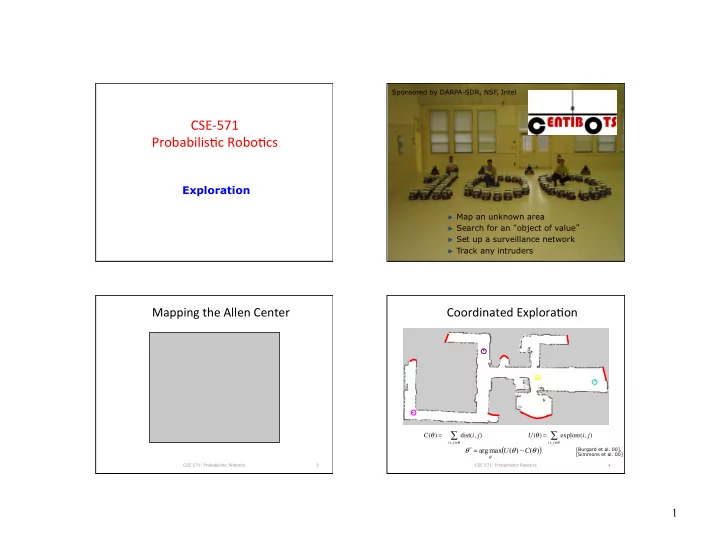

Sponsored by DARPA-SDR, NSF, Intel CSE-571 Probabilis1c Robo1cs Exploration ► Map an unknown area ► Search for an “ object of value ” ► Set up a surveillance network ► Track any intruders SA-1 SA-1 Mapping the Allen Center Coordinated Explora1on ∑ ∑ C ( θ ) = U ( θ ) = dist( i , j ) explore( i , j ) ( i , j ) ∈ θ ( i , j ) ∈ θ ( ) θ ∗ = θ − θ arg max U ( ) C ( ) [Burgard et al. 00], [Simmons et al. 00] θ CSE 571: Probabilistic Robotics 3 CSE 571: Probabilistic Robotics 4 1
Mul1-Robot Mapping With Known Start Mul1-Robot Mapping With Known Start Loca1ons Loca1ons CSE 571: Probabilistic Robotics 5 CSE 571: Probabilistic Robotics 6 Why are Unknown Start Loca1ons Hard? Mul1-robot Map Merging • Problems – Number of possible merges is exponen1al in number of robots – Cannot merge maps by simply overlaying them • Wanted Robot A Robot B Robot C – Scalability, robustness – Merge maps as soon as possible ► Need to know whether or not maps overlap ► Need to know how maps overlap CSE 571: Probabilistic Robotics 7 CSE 571: Probabilistic Robotics 8 2
Mul1-robot Map Merging Mul1-robot Map Merging CSE 571: Probabilistic Robotics 9 CSE 571: Probabilistic Robotics 10 Mul1-robot Map Merging Es1ma1ng rela1ve loca1ons • Idea: Localize one robot in other robot ’ s map using par1cle filter • Problems: – Only par1al map available – Other robot might be outside the map – Map grows – Impossible to keep track of all loca1ons inside and outside the par1al map • Solu1on: Only keep track of trajectories that overlapped map at some 1me CSE 571: Probabilistic CSE 571: Probabilistic Robotics 11 12 Robotics 3
Par1al map localiza1on (intui1on) Par1al map localiza1on (example) • Overlapping trajectories = p ( x | z , u ) − t 1 : t 1 : t 1 [ ] ∫ α ⋅ + p ( z | x ) p ( x | x , u ) p ( x | z , u ) dx p ( x | n , u ) p ( n | z , u ) t t t t t − 1 t − 1 t − 1 1 : t − 1 1 : t − 2 t − 1 t t − 1 t − 1 t − 1 1 : t − 1 1 : t − 2 • Non-overlapping trajectories = α − ε p ( n | z , u ) p ( z | outside )( 1 ) p ( n | z , u ) t 1 : t 1 : t − 1 t t t − 1 1 : t − 1 1 : t − 2 CSE 571: Probabilistic CSE 571: Probabilistic 13 14 Robotics Robotics Coordina1on Experimental setup ⎧ dist( i , j ) ∑ if j is frontier ∑ ⎧ explore( i , j ) if j is frontier θ = θ = ∑ C ( ) dist( i , j ) U ( ) ∑ explore( i , j ) θ = θ = C ( ) ⎨ U ( ) ⎨ + dist( i , j ) meet( i ∈ , θ j ) if j is hypothesis ∈ θ p ( j ) merge( i , j ) if j is hypothesis ⎩ ( i , j ) ( i , j ) ⎩ ( i , j ) ∈ θ ( i , j ) ∈ θ ( ) θ ∗ = θ − θ arg max U ( ) C ( ) Hypotheses become potential goals [Burgard et al. 00], θ [Simmons et al. 00], CSE 571: Probabilistic [Zlot et al. 02] CSE 571: Probabilistic 15 16 Robotics Robotics 4
Cen1Bots: Experimental Evalua1on • Rigorously tested by outside evalua1on team • No tes1ng allowed in 1/2 of environment • Limited communica1on • No interven1on / observa1on during experiment • Comparison to “ ground truth ” map CSE 571: Probabilistic Robotics 17 CSE 571: Probabilistic Robotics 18 Control Center and Test Team CSE 571: Probabilistic Robotics 19 CSE 571: Probabilistic Robotics 20 5
Three Mapping Runs Comparison to “ Ground Truth Map ” CSE 571: Probabilistic Robotics 21 CSE 571: Probabilistic Robotics 22 Courtesy of Vijay Kumar Three Overlayed Maps 3D Explora1on [Shen-Michael-Kumar: IIJRR-2012] CSE 571: Probabilistic Robotics 23 CSE 571: Probabilistic Robotics 24 6
[Krainin-Henry-Ren-F: IJRR-11] [Krainin-F-Curless: ICRA-11] Uncertainty in Object Surface ¡ EKF with ar1culated ICP over manipulator joint angles, camera ¡ Signed-distance func1on voxel grid [Curless ’96] pose and pose of (par1al) object ¡ Surface uncertainty from beam-based noise model CSE 571: Probabilistic Robotics 25 CSE 571: Probabilistic Robotics 26 View Selec1on Algorithm Re-Grasp Selec1on • Conceptually similar to Planetarium • Generate candidate grasps [Diankov ‘10] Algorithm [Connolly ’85] • Select grasp by maximum informa1on gain, accoun1ng for occlusion caused by grasp • Procedure: – Generate kinema1cally achievable viewpoints – Compute informa1on gain (quality) for each viewpoint – Select view as tradeoff between quality and cost CSE 571: Probabilistic Robotics 27 CSE 571: Probabilistic Robotics 28 7
Mul1ple Grasp Results Ac1ve Object Modeling • Evaluated regrasping on four objects • Includes box with three grasps CSE 571: Probabilistic Robotics 29 CSE 571: Probabilistic Robotics 30 Ac1ve Mapping • View selec1on for mapping and segmenta1on CSE 571: Probabilistic Robotics 31 8
Recommend
More recommend